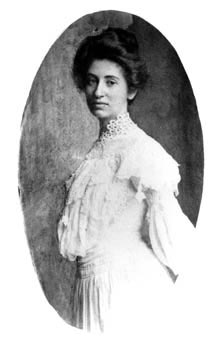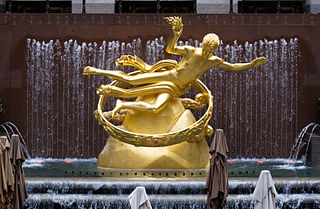
Miracle Mile is a neighborhood in the city of Los Angeles, California.

The Hollywood Palladium is a theater located at 6215 Sunset Boulevard in Hollywood, California. It was built in a Streamline Moderne, Art Deco style and includes an 11,200-square-foot (1,040 m2) dance floor including a mezzanine and a floor level with room for up to 4,000 people. The theater was listed on the National Register of Historic Places in 2016. The Palladium was designated Los Angeles Historic Cultural Monument No. 1130 on September 28, 2016.

The history of Santa Monica, California, covers the significant events and movements in Santa Monica's past.

Streamline Moderne is an international style of Art Deco architecture and design that emerged in the 1930s. Inspired by aerodynamic design, it emphasized curving forms, long horizontal lines, and sometimes nautical elements. In industrial design, it was used in railroad locomotives, telephones, toasters, buses, appliances, and other devices to give the impression of sleekness and modernity.

Mary Elizabeth Jane Colter was an American architect and designer. She was one of the very few female American architects in her day. She was the designer of many landmark buildings and spaces for the Fred Harvey Company and the Santa Fe Railroad, notably in Grand Canyon National Park. Her work had enormous influence as she helped to create a style, blending Spanish Colonial Revival and Mission Revival architecture with Native American motifs and Rustic elements, that became popular throughout the Southwest. Colter was a perfectionist, who spent a lifetime advocating and defending her aesthetic vision in a largely male-dominated field.

The Pellissier Building and adjoining Wiltern Theatre is a 12-story, 155-foot (47 m) Art Deco landmark at the corner of Wilshire Boulevard and Western Avenue in Los Angeles, California. The entire complex is commonly referred to as the Wiltern Center. Clad in a blue-green glazed architectural terra-cotta tile and situated diagonal to the street corner, the complex is considered one of the finest examples of Art Deco architecture in the United States. The Wiltern building is owned privately, and the Wiltern Theatre is operated by Live Nation's Los Angeles division.

Stiles Oliver Clements was an architect practicing in Los Angeles and Southern California.

The Beverly Hills Hotel, also called the Beverly Hills Hotel and Bungalows, is located on Sunset Boulevard in Beverly Hills, California. One of the world's best-known hotels, it is closely associated with Hollywood film stars, rock stars, and celebrities. The hotel has 210 guest rooms and suites and 23 bungalows and the exterior bears the hotel's signature pink and green colors.
Pico Boulevard is a major Los Angeles street that runs from the Pacific Ocean at Appian Way in Santa Monica to Central Avenue in Downtown Los Angeles, California, USA. It is named after Pío Pico, the last Mexican governor of Alta California.
Ahmad Adaya (1927–2006) was an American real estate tycoon and philanthropist who was the founding partner of a California real estate company IDS Real Estate Group. He was known for establishing the New Horizon School for Muslim religious education in southern California.
Claud W. Beelman, sometimes known as Claude Beelman, was an American architect who designed many examples of Beaux-Arts, Art Deco, and Streamline Moderne style buildings. Many of his buildings are listed on the National Register of Historic Places.

The Hotel Casa del Mar is a historic luxury hotel located on the beach in Santa Monica, California. It is owned and operated by the Edward Thomas Collection of Hotels.

The Superior Oil Company Building is a 12-story marble-clad high-rise building located at 550 S Flower St in Downtown Los Angeles. It was converted to The Standard Downtown LA hotel in 2002. The hotel closed in 2020 and will reopen in 2023 as The Delphi Hotel.

The Sunset Tower Hotel, previously known as The St. James's Club and The Argyle, is a historic building and hotel located on the Sunset Strip in West Hollywood, California. Designed in 1929 by architect Leland A. Bryant, opened in 1931, it is considered one of the finest examples of Art Deco architecture in the Los Angeles area. In its early years, it was the residence of many Hollywood celebrities, including John Wayne and Howard Hughes. After a period of decline in the early 1980s, the building was renovated and has been operated as a luxury hotel under the names The St. James's Club, The Argyle, and most recently the Sunset Tower Hotel. The building was added to the National Register of Historic Places in 1980.

Samuel Tilden Norton, or S. Tilden Norton as he was known professionally, was a Los Angeles-based architect active in the first decades of the 20th century. During his professional career he was associated with the firm of Norton & Wallis, responsible for the design of many Los Angeles landmarks.

The Streamline Hotel is a hotel located in Daytona Beach, Florida. Opened in 1941, it is the recognized birthplace of the National Association for Stock Car Auto Racing (NASCAR).

The Beverly Hills 9/11 Memorial Garden is a memorial space in honor of the victims of the September 11 attacks in Beverly Hills, California at the corner of North Rexford Drive and South Santa Monica Boulevard/Burton Way. Dedicated on September 11, 2011, exactly ten years after the attack, it is centered on a 30-foot bent steel beam salvaged from the wreckage of the World Trade Center. It was entirely funded by private donors. It forms part of the grounds of the Beverly Hills Fire Department.

Benjamin J. "Ben" Allen is an American attorney and Democratic politician. He has been a California state senator representing the 26th district since 2015. He previously served as University of California Student Regent and Santa Monica-Malibu Unified School District school board member.

The Art Deco style, which originated in France just before World War I, had an important impact on architecture and design in the United States in the 1920s and 1930s. The most famous examples are the skyscrapers of New York City including the Empire State Building, Chrysler Building, and Rockefeller Center. It combined modern aesthetics, fine craftsmanship and expensive materials, and became the symbol of luxury and modernity. While rarely used in residences, it was frequently used for office buildings, government buildings, train stations, movie theaters, diners and department stores. It also was frequently used in furniture, and in the design of automobiles, ocean liners, and everyday objects such as toasters and radio sets. In the late 1930s, during the Great Depression, it featured prominently in the architecture of the immense public works projects sponsored by the Works Progress Administration and the Public Works Administration, such as the Golden Gate Bridge and Hoover Dam. The style competed throughout the period with the modernist architecture, and came to an abrupt end in 1939 with the beginning of World War II. The style was rediscovered in the 1960s, and many of the original buildings have been restored and are now historical landmarks.



















